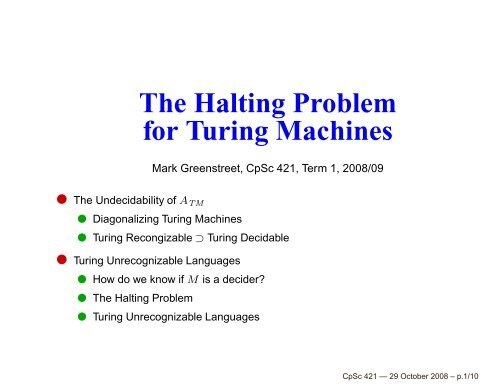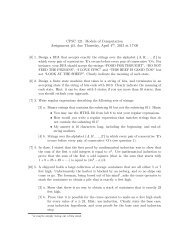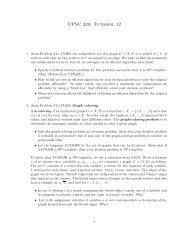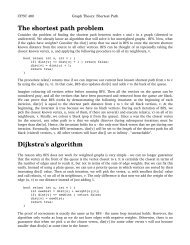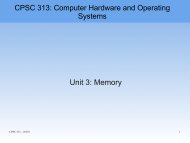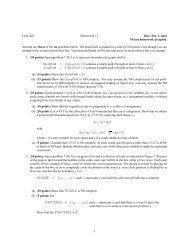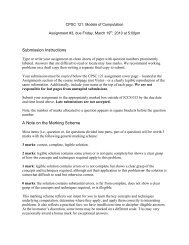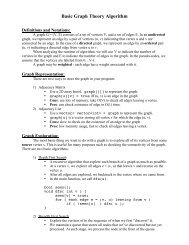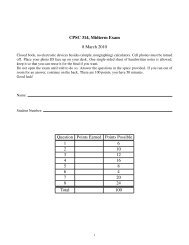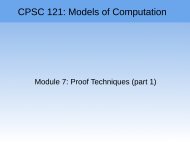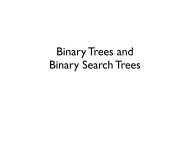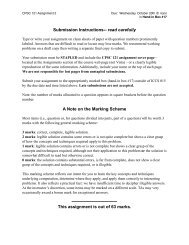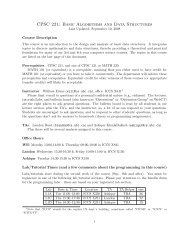The Halting Problem for Turing Machines - Ugrad.cs.ubc.ca
The Halting Problem for Turing Machines - Ugrad.cs.ubc.ca
The Halting Problem for Turing Machines - Ugrad.cs.ubc.ca
Create successful ePaper yourself
Turn your PDF publications into a flip-book with our unique Google optimized e-Paper software.
<strong>The</strong> <strong>Halting</strong> <strong>Problem</strong><strong>for</strong> <strong>Turing</strong> <strong>Machines</strong>Mark Greenstreet, CpSc 421, Term 1, 2008/09✈ <strong>The</strong> Undecidability of ATM✉ Diagonalizing <strong>Turing</strong> <strong>Machines</strong>✉ <strong>Turing</strong> Recongizable ⊃ <strong>Turing</strong> Decidable✈ <strong>Turing</strong> Unrecognizable Languages✉ How do we know if M is a decider?✉ <strong>The</strong> <strong>Halting</strong> <strong>Problem</strong>✉ <strong>Turing</strong> Unrecognizable LanguagesCpSc 421 — 29 October 2008 – p.1/10
Trying to Decide A TM✈ ATM = {M#w | <strong>Turing</strong> machine M accepts string w}✉ ATM is <strong>Turing</strong> recognizable:We constructed a <strong>Turing</strong> Machine, U that recognizes A TM in the October 27lecture.✉ U was not a decider – it would loop on input M#w if M loops on input w.✉ Can we make a <strong>Turing</strong> machine that decides ATM ?This machine must halt (either accept or reject) <strong>for</strong> all possible inputs.✈ Assume that E is a TM that decides ATM .We’ll show that this leads to a contradiction on the next few slides.CpSc 421 — 29 October 2008 – p.2/10
A TM Is Undecidable✈ ATM = {M#w | M describes a TM that accepts string w}✈ Let D be a <strong>Turing</strong> machine that does not have # in its input alphabet. On input w, Ddoes the following:✉ Appends #w onto its input tape to produce w#w.✉ Runs E (the decider <strong>for</strong> ATM ) as a “subroutine”. If E accepts w#w, D rejects. If E rejects w#w, D accepts.✈ Now, run D with its own description as its input:✉ If E says that D accepts when run with D as input,then D rejects when run with D as input.✉ If E says that D rejects when run with D as input,then D accepts when run with D as input.✉ Either way, we have a contradiction.✈ ∴ E <strong>ca</strong>nnot exist.✉ <strong>The</strong>re is no TM that decides ATM .✉ ATM is not <strong>Turing</strong> decidable.CpSc 421 — 29 October 2008 – p.3/10
Why is this Diagonalization?✈ <strong>The</strong> set of all <strong>Turing</strong> machines is countable:✉ <strong>Turing</strong> <strong>Machines</strong> <strong>ca</strong>n be described by strings. In the October 27 lecture we described TMs using strings over the alphabetΣ TM = {0, 1, (, ,, )}. Not all strings are valid TM descriptions. Thus, |TM | ≤ |Σ∗TM| = |N|.✉ For every k ≥ 3 there is a valid TM with k states. Thus |TM | ≥ |N|.✉ We conclude that |TM | = |N|.✈ <strong>The</strong> set of all languages is uncountable.<strong>The</strong> set of all languages has size 2 |Σ∗| = 2 |N| .✈ <strong>The</strong>re are more languages than there are <strong>Turing</strong> machines.∴ <strong>The</strong>re are languages that are neither <strong>Turing</strong> decidable nor recognizable.CpSc 421 — 29 October 2008 – p.4/10
Why is this Diagonalization?✈ <strong>The</strong> set of all <strong>Turing</strong> machines is countable:✈ <strong>The</strong> set of all languages is uncountable.<strong>The</strong> set of all languages has size 2 |Σ∗| = 2 |N| . For example, with Σ = {0, 1} wehave:ǫ 0 1 00 01 10 11 000 . . .L 0 R R R R R R R R . . .L 1 A R R R R R R R . . .L 2 R A R R R R R R . . .L 3 A A R R R R R R . . .L 4 R R A R R R R R . . .. ... . . . . . . . .✈ <strong>The</strong>re are more languages than there are <strong>Turing</strong> machines.∴ <strong>The</strong>re are languages that are neither <strong>Turing</strong> decidable nor recognizable.CpSc 421 — 29 October 2008 – p.4/10
Constructing an Undecidable Language✈ Consider the matrix where entry (i, j) is 1 iff <strong>Turing</strong> machine iaccepts the string that encodes <strong>Turing</strong> machine j:M 0 M 1 M 2 . . . M 117 M 118 M 119 . . .M 0 ∞ ∞ ∞ . . . ∞ ∞ ∞ . . .M 1 A A A . . . A A A . . .M 2 R R R . . . R R R . . .........M 117 A ∞ R . . . R R A . . .M 118 R R R . . . ∞ ∞ ∞ . . .M 119 R A ∞ . . . R A A . . .......... ..✈ Let LD be the language{M i | <strong>Turing</strong> machine M i does not accept input M i }:CpSc 421 — 29 October 2008 – p.5/10
Constructing an Undecidable Language✈ Consider the matrix where entry (i, j) is 1 iff <strong>Turing</strong> machine iaccepts the string that encodes <strong>Turing</strong> machine j:M 0 M 1 M 2 . . . M 117 M 118 M 119 . . .M 0 R R R . . . R R R . . .M 1 A A A . . . A A A . . .M 2 R R R . . . R R R . . .......... ..M 117 A ∞ R . . . R R A . . .M 118 R R R . . . ∞ ∞ ∞ . . .M 119 R A ∞ . . . R A A . . .......... ..✈ Let LD be the language{M i | <strong>Turing</strong> machine M i does not accept input M i }:M 0 M 1 M 2 . . . M 117 M 118 M 119 . . .– p.5/10
Constructing an Undecidable Language✈ Consider the matrix where entry (i, j) is 1 iff <strong>Turing</strong> machine iaccepts the string that encodes <strong>Turing</strong> machine j:✈ Let LD be the language{M i | <strong>Turing</strong> machine M i does not accept input M i }:M 0 M 1 M 2 . . . M 117 M 118 M 119 . . .L D A R A . . . A A R . . .✈ <strong>The</strong>re is no TM in our list that recognizes LD –that’s the diagonalization.✈ LD is the language that we tried to construct D to decide.CpSc 421 — 29 October 2008 – p.5/10
Diagonalization and <strong>Halting</strong>✈ ATM is not <strong>Turing</strong> decidable (slide 3).✈ ATM is <strong>Turing</strong> recognizable (October 27 lecture).✉ <strong>The</strong> set of <strong>Turing</strong> recognizable languages is strictly larger than the set of <strong>Turing</strong>decidable languages.✉ This is be<strong>ca</strong>use a recognizer is allowed to loop: failure to halt means the inputstring is not in the language recognized by the recognizer.✈ LD = {M | M#M ∈ A TM } is not <strong>Turing</strong> recognizable (slide 5).✉ This is be<strong>ca</strong>use the recognizer must halt whenever M loops when run withinput M.✉ In fact, we could modify our machines to never use the reject state — theycould just loop to reject.✉ <strong>The</strong>n, recognizing LD would mean determining that the machine will never halt.✉ Our argument that LD is not <strong>Turing</strong> recognizable shows that this variant is not<strong>Turing</strong> recognizable.✈ ∴ HALT = {M#w | <strong>Turing</strong> machine M halts when run with input w} is <strong>Turing</strong>recognizable but not <strong>Turing</strong> decidable.✉ HALT is not even <strong>Turing</strong> recognizable.CpSc 421 — 29 October 2008 – p.6/10
<strong>Turing</strong> Co-Recognizable Languages✈ <strong>The</strong> class of <strong>Turing</strong> decidable languages is closed undercomplement.✈ <strong>The</strong> class of <strong>Turing</strong> recognizable languages is not closed undercomplement.✉ We say that a language, L, is <strong>Turing</strong> co-recognizable iff the complement of L is<strong>Turing</strong> recognizable.✉ For example, the languageLOOPS = {M#w | <strong>Turing</strong> machine M loops when run with input w} is <strong>Turing</strong>co-recognizable be<strong>ca</strong>use it is the complement of HALT, a <strong>Turing</strong> recognizablelanguage.CpSc 421 — 29 October 2008 – p.7/10
Relating Recognizability✈ If a language is <strong>Turing</strong> recognizable and <strong>Turing</strong> co-recognizable,then it is <strong>Turing</strong> decidable.✉ Let L be a language that is both <strong>Turing</strong> recognizable and co-recognizable.✉ Be<strong>ca</strong>use L is <strong>Turing</strong> recognizable, there is a <strong>Turing</strong> machine, ML that <strong>for</strong> anyw ∈ L accepts w, and <strong>for</strong> any w ∉ L rejects or loops.✉ Be<strong>ca</strong>use L is <strong>Turing</strong> co-recognizable, there is a <strong>Turing</strong> machine, Mco−L that <strong>for</strong>any w ∉ L rejects w, and <strong>for</strong> any w ∈ L accepts or loops.✉ Now, we build a new TM, N that has two tapes, one <strong>for</strong> ML and one <strong>for</strong>M co−L . Each step of L takes a step <strong>for</strong> each of M L and M co−L . If M Laccepts or M co−L rejects, then N accepts. Likewise, if M L rejects or M co−Laccepts, N rejects. N is guaranteed to halt.✉ N is a TM that decides L.✉ ∴ L is <strong>Turing</strong> decidable.CpSc 421 — 29 October 2008 – p.8/10
Why Allow Loopy <strong>Machines</strong>?✈ Couldn’t we just insist that we’ll only consider TM’s that halt on allinputs (i.e. deciders)?✈ <strong>Problem</strong> 1:✉ We could do this, and our diagonalization would still work.✉ <strong>The</strong> obvious way to construct a TM <strong>for</strong> the diagonal (slide 3) produces a TMthat loops. Language L D remains undecidable.✈ <strong>Problem</strong> 2: How do we know if a TM is a decider?✉ This is the question of whether or not a TM halts on all inputs, not just on one,specific input.✉ We say that a TM is total iff it halts on all inputs, and we writeTOTAL = {M | M is a TM that halts on all inputs}✉ <strong>The</strong> language TOTAL is neither <strong>Turing</strong> recognizable nor co-recognizable.✉ Thus, deciding whether or not a TM is a decider is even harder than the haltingproblem.CpSc 421 — 29 October 2008 – p.9/10
This coming week (and beyond)✈ Reading✉ Today: Sipser, 4.1✉ Oct. 29 (Today): Sipser, 4.2✉ Oct. 31 (Friday): Sipser, 5.1✉ Nov. 3 (Monday): Midterm review.✉ Nov. 5 (A week from Today): Midterm 2.✈ Homework✉ Oct. 31 (Friday): Homework 7 due, Homework 8 goes out.No late homework accepted <strong>for</strong> homework 7.Homework 8 is extra credit.CpSc 421 — 29 October 2008 – p.10/10
Undecidability FAQ✈ Where did E come from?✉ <strong>The</strong> proof is by contradiction. To prove that ATM is undecidable, we assumethe opposite, namely that A TM is decidable, and show that this leads to acontradiction. This contradiction shows that one of our assumptions must havebeen false. In particular, it shows that our assumption that A TM is notundecidable (i.e. that it is decidable) is false. From that, we conclude that A TMis undesidable.✉ You <strong>ca</strong>n think of this as a “game with an adversary.” You claim that ATM is <strong>Turing</strong> undecidable. I (the adversary) claims that ATM is <strong>Turing</strong> decidable. You go to the definition of “<strong>Turing</strong> decidable:”A language is <strong>Turing</strong> decidable iff there exists a TM that decides it. ATM, M, decides a language A iff <strong>for</strong> every input string w: if w ∈ A then M accepts w; if w ∉ A, M rejects w; there is no w <strong>for</strong> which M loops.Based on this definition, you ask me to show you a TM that decides A TM .✉ Continued on the next slide.CpSc 421 — 29 October 2008 – p.11/10
Undecidability FAQ (cont.)✈ Where did E come from?✉ You <strong>ca</strong>n think of this as a “game with an adversary.” You claim that ATM is <strong>Turing</strong> undecidable. I (the adversary) claims that ATM is <strong>Turing</strong> decidable. You ask me to show you a TM that decides ATM . I give you the description of some TM, E.This is where E comes from: I (the adversary) am obligated to produce anE <strong>for</strong> you if A TM is indeed <strong>Turing</strong> decidable. Based on E, you construct a new TM, D such that D accepts w if E rejects w#w; D rejects w if E accepts w#w.Be<strong>ca</strong>use E is a decider, E never loops. Thus, D never loops as well. Seeslide 3 <strong>for</strong> more details on how to construct D. Now, you propose running D with the string that describes D as its input. (continued on the next slide).CpSc 421 — 29 October 2008 – p.12/10
Undecidability FAQ (cont.)✈ Where did E come from?✉ You <strong>ca</strong>n think of this as a “game with an adversary.” . . . Now, you propose running D with the string that describes D as its input. D constructs the string D#D and hands it to E. From the definition of ATM , E accepts D#D iff D accepts when runwith its own description as its input. If fact, we are running D with its owndescription as its input. If E accepts then D rejects.This means that E said that D accepts when run with its own descriptionas its input, and D in fact rejected when run with its own description asits input. If E rejects then D accepts.This means that E said that D rejects when run with its own descriptionas its input, and D in fact accepted when run with its own description asits input. Either way, E is wrong. Thus, E is not the decider <strong>for</strong> ATM that I (theadversary) claimed it is. This shows that there is no TM that decides ATM . In other words, A TM isnot <strong>Turing</strong> decidable.CpSc 421 — 29 October 2008 – p.13/10
Undecidability FAQ (cont.)✈ Where did E come from?✉ Game with an adversary (summary): You claim that ATM is <strong>Turing</strong> undecidable. I (the adversary) claims that ATM is <strong>Turing</strong> decidable. You ask me to show you a TM that decides ATM . I give you the description of some TM, E. Based on E, you construct a new TM, D such that accepts w iff E rejectsw#w. Now, you propose running D with the string that describes D as its input. D constructs the string D#D and hands it to E. If E accepts then D rejects and thereby contradicts E’s decision. If E rejects then D accepts and thereby contradicts E’s decision. Either way, E is wrong. This shows that there is no TM that decides ATM . In other words, A TM isnot <strong>Turing</strong> decidable.CpSc 421 — 29 October 2008 – p.14/10
Undecidability FAQ: does E loop?✈ Can we conclude that E loops when run input D#D?✉ This may seem reasonable, this is what machine U from the October 27 slideswould do.✉ But that’s not the only way that E <strong>ca</strong>n fail. For example, we could keep track of all configurations that we’ve seen so farand detect looping if a configuration is repeated. We could apply more sophisti<strong>ca</strong>ted tests as well, but What if one of these tests is wrong?✉ E could report that TM M accepts string w when M in fact loops on input w. How would you know that E was wrong? You could try running M with input w, but if after a while you <strong>ca</strong>me back andtold me that it seems to be looping even though E says it should accept, I<strong>ca</strong>n reply that you just haven’t run it <strong>for</strong> long enough yet. How <strong>ca</strong>n you determine that you’ve run M long enough? –How <strong>ca</strong>n you decide that E is wrong? In general, you <strong>ca</strong>n’t.✉ See the next slide <strong>for</strong> a bit more.CpSc 421 — 29 October 2008 – p.15/10
Undecidability FAQ (cont.)✈ Can we conclude that E loops when run input D#D?✉ It was Penrose’s mistake in <strong>The</strong> Emporer’s New Mind. Penrose assumed that be<strong>ca</strong>use E would be wrong if it accepted or if itrejected, then E must loop when run with D#D as described above. BUT, E is wrong if it loops.E is supposed to be a decider.If I (in the adversary argument described above) give you a TM that loops<strong>for</strong> some inputs and claim that it’s a decider, then I’ve failed to hold up myend of the bargain.If E is supposed to be a decider and it loops,then it is just as wrong as it is if it incorrectly accepts or rejects. When Penrose concluded that E loops, he inserted a contradiction into hisargument be<strong>ca</strong>use he had previously assumed that E was a decider. Given that Penrose was arguing from inconsistent assumption, he couldconclude anything. Penrose has the excuse that he’s a brilliant physicist who happens to beclueless about computer science. You are a computer science student and don’t have Penrose’s excuse.Read this FAQ and avoid those mistakes – you wouldn’t want toembarrass yourself at a party this weekend making silly claims aboutdecidability results.CpSc 421 — 29 October 2008 – p.16/10


